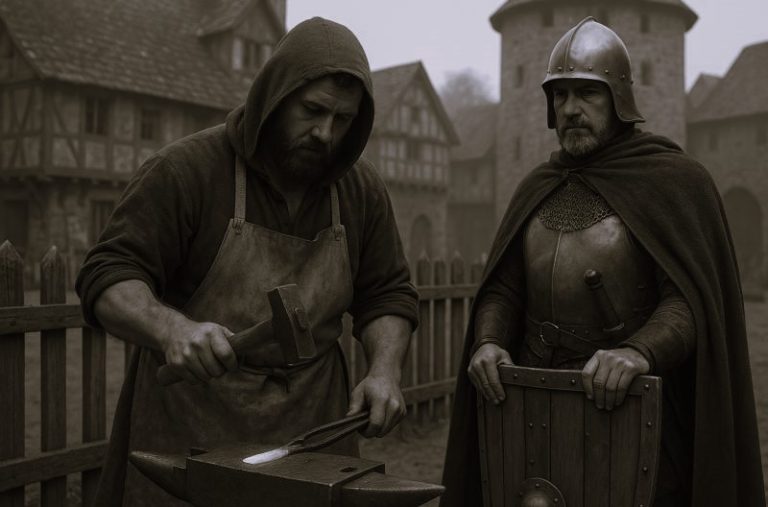

When one is “brewminating” over the middle ages, anywhere between the collapse of the Roman empire to the Age of Enlightenment, translation and transcription may not be the first thing that come to mind. However, what, if anything would have been known without monks providing translation and transcription services, even if only for kings and the priestly classes? Even many historical records of Roman times would have been lost had it not been for the occasional king commanding the service of scribes to translate and transcribe ancient Roman documents in direct contradistinction to orders by the clergy.
While the transcription services provided by scribes are fairly well documented, much has been lost in terms of translation that took place throughout the dark ages. The most common translations in the early phases of the dark ages, were in some instances, merely a continuation of the work started largely before and during the rise of Constantine, and focusing on both law and religious texts.
Among the most notable examples of transcription and translation may be seen in the works of Josephus. Most of his works were written in what is now considered to be ancient Greek, though he translated some of his works into both Hebrew and Aramaic (more commonly known as Syriac at the time) and it is presumed that he was capable of communications in Latin as well, though being born Titus Flavius Josephus, a Judea-Roman, it is difficult to imagine how this could be seriously debated.
The Growth of Writing, Transcription and Translation in Constantinople
While the first days of greatness for the Constantine empire may have preceded the dark ages by a few decades, they are notable in that the writing, transcription and translation that took place during this period of history have few comparisons in terms of their impact on the known world.
This period saw the first formal codification of the law through the compilation known as the Corpus Juris Civilis or Codex Justinianus, a complete transcription of the body of civil law. This writing was followed in short order by the creation of the Codex Repetitae Praelectionis, which was the second edition of the Codex Justinianus.
This period also saw a great many scribes focusing on the translation of many of the ancient Hebrew scriptures into the current canonical scriptures of the day. These texts were translated from the ancient Hebrew into Greek (or what is now more commonly known as Ancient Greek), Latin and Aramaic.
Many of the oral traditions of the relatively new Christian religion were also being translated en masse as the rule of Constantine spread throughout the lands. These translations of the Aramaic or Syriac texts into the ancient Greek soon became what is known as the Greek Vulgate with the Latin translations being canonized as the Latin Vulgate.
Such a feat of translation and transcription would hardly seem worth mentioning in the digital day and age, but at the time, each and every page had to be cut independently of the other, and quite literally, every word would have to be written down by hand. In today’s digital era, ‘Conference call note taking‘ services have revolutionized this process, allowing for real-time, efficient transcription that captures every detail without the painstaking manual effort of the past.
It would not be until 1440 that Johannes Gutenberg would invent the printing press, and it would not be perfected until some time around 1450. Given the relatively exorbitant rates at which individuals capable of translating and transcribing commanded during the middle ages, books were largely restricted to the priesthood and royalty.
Translation and Transcription Among the Priestly and Religious Classes
It was once believed that the original written canonical scriptures did not extend beyond the year 6000 BCE (Before the Common Era) or BC (Before Christ). This seemed readily apparent as it was believed that the ancient Hebrew writing was no older than that.
In 2010 however, a discovery was made, including ancient Hebrew text that dated back to somewhere around ten thousand BC or BCE. The implications were that the Bible may in fact be much older than originally believed, as was noted in Live Science magazine.
There is little doubt that the Jewish people have suffered extensively throughout their history. If any group may have been punished nearly as much, it may well have been the Christians as they rose to prevalence within the Roman Empire, much to the consternation of many a Roman Citizens, and not just a few of the Jewish leaders of the day.
In 313 AD (After Death or after the death of the Christ) or CE (Common Era), the Roman Emperor Constantine, having converted to Christianity, along with the Roman Emperor Licinius, signed the Edict of Milan that officially ended the persecution of Christians within the Roman empire. There can be little doubt that the political power of Constantine also greatly influenced the Christian sect which would ultimately become known as the Roman Catholic diocese.
While it may be something of a controversial opinion to take these days, perhaps more so among the traditional, Orthodox churches, throughout the middle ages, there was virtually no distinction between the Christian religion and what is known today as the Roman Catholic Diocese.
Whether through divine intervention or as a reflection of the power vested into it by the Emperor Constantine, the Apostolic or Papal Succession of the church continued to hold direct sway over king and commoner alike throughout the dark ages. It was also through the Church that many scribes would learn the arts of languages, translation and transcription.
The Abbey of Monte Cassino was established somewhere around the year 529 (AD or CE) by Benedict of Nursia, soon to become Saint Benedict, the namesake of the Benedictine order of the Monks. During this same period, he would also write what would become the Regula Sancti Benedicti or Rule of Saint Benedict which would become the authority for the orders of Monks living the Monastic lifestyle.
Given the position of wealth and power granted to (or inherited through divine right as some may claim) the Christians, the monastic method served as the primary centers for the storing and continuation of knowledge. This would ultimately lead to the formation of more formal educational institutions.
During the middle ages however, this merely meant that the monasteries were the most common place for monks to learn and master linguistic skills, and to serve in the capacity of transcribers and translators, often laboring weeks to transcribe a single copy of a book.
Translation and Transcription Among the Royal Classes
The religious texts and books were among the most ornate and difficult for the purposes of transcription, so such scribes could generally demand a much better salary when working in the private sector. It should be noted that scribes offering transcription services were surprisingly common throughout the middle ages.
While this may go against some of the more traditional beliefs, it remains a verifiable though little known fact. Scribes seemed to have become more prevalent in the more basic transcription services somewhere around the end of the dark ages. Even then, may have often been overruled or guided by the principles of landlords, members of royalty, or others in more of a position of authority whom the person paying for the scribe may be forced to trust.
What is notably different, is the level of skill and the work provided during the process of transcription. A scribe hired to write out the terms of a legal document would not need the same skills as a scribe hired to copy a very ornate and long-lasting book. Books were generally considered to be somewhat luxurious in nature, generally owned by the wealthy and powerful, though not a frequent possession of the commoners of the time.
During the ninth century, a paper known as the Decretum Glasianum was published. While there were others before it, none were officially acknowledged until the publication of the Index Librorum Prohibitorum in 1559. This decree banning selected writings was continued by the Church up until 1966.
Among the most notable Biblical books were those included in the Apocrypha. These changes to the Canonical scriptures were sometimes thought to be similar to other “apocryphal writings” including many Helenistic scriptures, and were removed from the Latin Vulgate during the Council of Trent in 1546 AD or CE, though they remain in the Greek Vulgate canonical scriptures.
What these lists established, were a series of historical books, texts and references that were prohibited by the Papacy and the Diocese. In other words, it was illegal for anyone to possess these items, much less read them, let alone to dare have them transcribed or translated.
While there are no official records that are readily available, some of these titles have been found in the collections of kings and other members of the royal class of the day. Among the most common were ancient Roman and even some Greek texts that, after the fall of Rome and the ascension of power by the Church, were deemed to be heretical in nature. While it is understandable how some books could be considered more heretical in nature, some of these banned books included writings about science, math and other more scholastic pursuits in their early forms.
Despite all of this, it would seem that these were not the only “forbidden books” of the day. Throughout the middle ages, books were considered a luxury item and were generally expensive to have transcribed or translated. Thus, as challenging as it may be to believe, there were a surprisingly large number of books of a more adult and exploratory nature.
A Raucous and Rich Period of Translation and Transcription Services
There were a shockingly large number of books from throughout Europe that were translated, primarily between German, French and English. What is truly shocking, given the expense of transcription and translation services necessary to create a book in those days, was the fact that these were “adult” books, some bordering on risque or erotic and some decidedly more pornographic in nature.
While erotica was not fully established as a separate genre all its own until sometime around the late seventeenth or early eighteenth century, there are a surprisingly large number of references and even source materials from the middle ages. This is seen by some, especially given the rarity of many of these intricate and detailed transcriptions, to be in many cases, translations of older Roman and even perhaps Greek texts that members of the royal class sought to “protect” from the church.
Still, a surprisingly large collection of erotic medieval literature remains as evidenced by this report published in the Daily Beast. A collection (“naughtily consisting of sixty-nine tales”) of old French tales more properly known as the fabliaux, has been translated and made available for the modern reader.
It is difficult to say how different history would be, not just for the loss of the written word, but for the love affair with books, even when such pains had to be taken in translation and transcription to create just a single work.
Translation and Transcription Pave the Way to Enlightenment
The middle ages are perhaps best known for the oral traditions including folklore, poetry, and ballads. There were also numerous texts and scripts that were recorded, most notably during the time of the crusades and in the form of religious texts. However, this perhaps lends even more power to the written word in the form of books during the middle ages.
Would Gutenberg still have been motivated to create the printing press without such a common love of books? While it is certainly possible that his printing of the Bible was motivated by deep spiritual influence, it may have also been merely because the Bible was the most common book of the day, and remains the best selling book of all times even today.
There were indeed excessive levels of work involved for the transcription and creation of each book by hand. Still, would the printing press ever have been created if people had not developed such a passion for the written word and the touch and feel of that book in their hands? Would it even be any real stretch to claim that the processes of translation and transcription, were in fact what moved us beyond the dark ages and ultimately introduced us to the world of knowledge which would eventually open the proverbial doors to the age of enlightenment?






